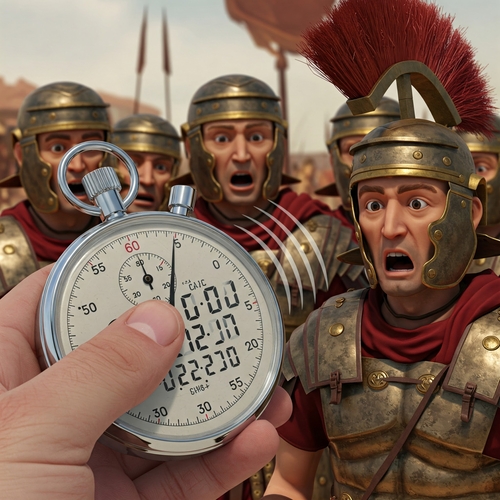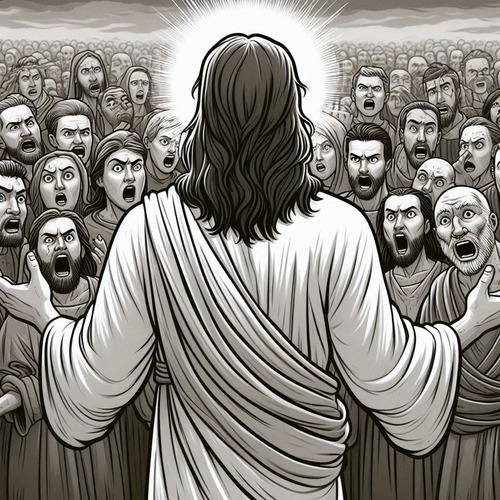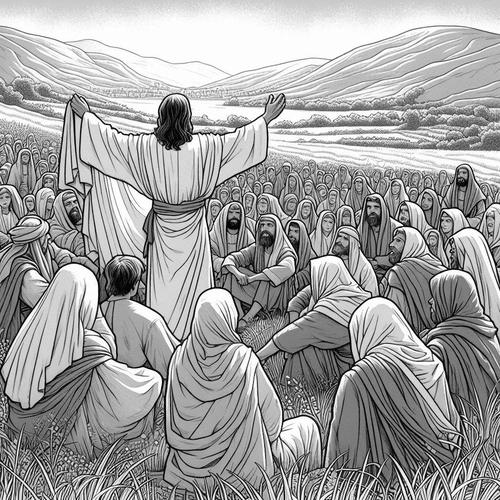Did Jesus Die Too Soon? Was Pilate’s Surprise Unfounded?
Sceptics point to Jesus’ relatively short time on the cross as evidence the Gospel accounts are unreliable. After all, when Pontius Pilate heard Jesus was already dead, Mark 15:44 tells us he was “surprised.” But was this death truly premature, or is there more to the story? Let’s examine the biblical record alongside medical understanding to discover why Christ’s death, while faster than some crucifixion victims, was entirely consistent with both Scripture and science.
THE TIMELINE OF JESUS’ CRUCIFIXION
The Gospel accounts provide a clear chronology of Jesus’ final hours:
- Crucifixion began around the third hour (9 AM) according to Mark 15:25
- Darkness covered the land from the sixth to the ninth hour (noon to 3 PM) as recorded in Mark 15:33
- Jesus cried out and breathed His last around the ninth hour (3 PM) as described in Mark 15:34-37
This places Jesus on the cross for approximately six hours. Since many crucifixion victims lingered for days, the shorter timeframe requires closer examination, rather than dismissal.
WHY WAS PILATE SURPRISED?
Roman crucifixion was designed as a method of slow, excruciating public torture and execution. Victims often survived for 24-48 hours, sometimes even longer. The prolonged suffering served as a powerful deterrent to would-be criminals and rebels.
Given this context, Pilate’s surprise at Jesus’ death after only six hours was natural. Yet importantly, Mark records Pilate didn’t simply accept the report—he called the centurion to verify Jesus’ death (Mark 15:44-45). This detail, rather than undermining the account’s credibility, actually strengthens it. Why would Gospel writers invent a detail that might raise questions about their narrative? This reads more like historical reporting than fabrication.
THE BRUTAL FACTS: WHY JESUS DIED “EARLY”
The Devastating Effects of Roman Scourging: Not all crucifixion victims underwent scourging beforehand, but Jesus did. Matthew 27:26 records Jesus was flogged before His crucifixion. The Roman flagrum (whip) was a devastating instrument:
- It consisted of leather thongs with pieces of bone, metal, or glass embedded in the tips
- Each lash tore through skin and underlying muscle tissue
- Blood loss was significant, often causing hypovolemic shock
- Some victims never survived this preliminary torture to reach crucifixion
The medical effects were catastrophic: extensive blood loss, traumatic shock, and severe tissue damage. This alone would have dramatically weakened Jesus before He even reached Golgotha.
Pre-Crucifixion Trauma: Beyond the scourging, Jesus endured:
- A sleepless night of trials and beatings
- A crown of thorns pressed into His scalp (Matthew 27:29)
- Being struck repeatedly in the face (Matthew 27:30)
- Carrying His cross beam until physically unable to continue (John 19:17)
By the time Jesus was nailed to the cross, His body had already endured trauma that many would not have survived.
Medical Causes of Death by Crucifixion: Modern medical analysis suggests several probable factors in Jesus’ death:
- Hypovolemic shock from blood loss during scourging and the wounds from the nails
- Traumatic asphyxia as the positioning on the cross made breathing increasingly difficult
- Cardiac rupture or failure, possibly indicated by the “blood and water” that flowed when His side was pierced (John 19:34)—consistent with pericardial effusion and pleural effusion
Medical experts who’ve studied crucifixion, such as Dr Frederick Zugibe (former Chief Medical Examiner of Rockland County, New York) and the Journal of the American Medical Association’s 1986 analysis, confirm these effects are consistent with the Gospel accounts.
THE THEOLOGICAL DIMENSION: JESUS’ SOVEREIGN CONTROL
From a Reformed perspective, the timing of Jesus’ death reflects divine sovereignty rather than medical anomaly. Jesus Himself declared: “No one takes [my life] from me, but I lay it down of my own accord” (John 10:18).
Notice these indicators of Christ’s control over His death:
- His loud cry just before death (Mark 15:37)—unusual for someone dying of asphyxiation
- His declaration “It is finished” (John 19:30), suggesting completion rather than defeat
- The precise timing coinciding with the evening Passover sacrifice
Scripture portrays Jesus not as a victim whose life ebbed away prematurely, but as the sacrificial Lamb who gave His life precisely when His atoning work was complete.
THE FINAL CONFIRMATION
John 19:34 records a soldier pierced Jesus’ side with a spear, causing blood and water to flow out. This served as final verification of death. Roman soldiers were experts at execution; they faced severe penalties for allowing a condemned criminal to survive. The centurion’s confirmation to Pilate that Jesus was indeed dead (Mark 15:45) represents a professional assessment, not a mistake.
CONCLUSION: DID JESUS DIE TOO SOON?
Jesus’ death after six hours on the cross was not premature in God’s sovereign timing, even if it surprised Pilate. The combination of extreme pre-crucifixion trauma, the physiological effects of crucifixion, and Christ’s voluntary surrender of His spirit fully explain the timeline presented in Scripture.
Pilate’s surprise doesn’t undermine the Gospel narrative—it authenticates it as honest historical reporting. The medical evidence supports rather than contradicts the biblical account.
For believers, this understanding deepens our appreciation of Christ’s sacrifice. He endured unimaginable suffering, and when the work of atonement was complete, He voluntarily yielded His spirit according to the Father’s perfect plan. As the Reformed tradition emphasises, every detail of Christ’s passion and death occurred precisely as God ordained—not a moment too soon, not a moment too late.
DID JESUS DIE TOO SOON? RELATED FAQs
Didn’t victims typically survive days on the cross, making Jesus’ six-hour crucifixion suspicious? While many crucifixion victims survived for days, historical records show significant variation based on the victim’s pre-crucifixion condition. Jesus endured exceptional trauma before crucifixion: a severe scourging that alone killed some victims, a sleepless night of beatings, and carrying the cross until collapse. These factors, combined with the medical effects of crucifixion, fully explain His shorter time on the cross.
- Could the Gospel accounts of Jesus’ death have been fabricated or exaggerated? The Gospel writers included precise medical details they couldn’t have scientifically known—like the “blood and water” from Jesus’ side—that modern medicine now recognises as consistent with crucifixion trauma. They also included potentially problematic details, like Pilate’s surprise at Jesus’ quick death, that fabricators would likely have omitted to avoid raising questions. These elements strongly suggest eyewitness testimony rather than fabrication.
- What does “blood and water” flowing from Jesus’ side actually indicate medically? When the soldier pierced Jesus’ side and “blood and water” flowed out (John 19:34), this likely indicated a separation of blood serum (appearing watery) from clotted blood cells, or potentially pericardial fluid (water) and blood from a cardiac rupture. The precise clinical detail, recorded long before modern medical understanding, suggests the phenomenon was observed firsthand and accurately reported. Modern medical experts recognise this as consistent with death by crucifixion following severe trauma.
If God exists and is really sovereign, can anything anywhere happen too soon? From a Reformed theological perspective, nothing in God’s creation happens “too soon” or outside His sovereign timing. While events may surprise humans based on our limited expectations, God works all things according to His perfect plan and purpose (Ephesians 1:11). Jesus Himself stated no one took His life, but He laid it down of His own accord (John 10:18), indicating the precise timing of His death fulfilled God’s redemptive purpose exactly as intended.
- Why would the Romans break the legs of crucifixion victims, and why didn’t they break Jesus’ legs? Romans would break the legs of crucifixion victims to accelerate death by preventing them from pushing up to breathe, causing rapid asphyxiation. This was particularly done when a quick death was needed, as with the thieves crucified with Jesus before the Sabbath began (John 19:31-32). They didn’t break Jesus’ legs because He was already dead, fulfilling the prophecy that “not one of his bones will be broken” (Psalm 34:20, John 19:36) and providing another verification of His actual death.
- Could Jesus have merely fainted or been in a coma rather than actually dying? The “swoon theory” suggesting Jesus merely fainted is medically implausible given the trauma He endured. Roman executioners were professionals who faced severe penalties for allowing victims to survive; the spear thrust to Jesus’ side ensured death and produced clear biological evidence of death. Furthermore, being wrapped tightly in burial cloths with 75 pounds of spices and sealed in a cold tomb would have guaranteed death even if He had somehow survived the cross.
Why did darkness cover the land during the crucifixion, and does this have any historical corroboration? The darkness from noon until 3 PM (Matthew 27:45) symbolised divine judgement as Jesus bore the sins of His people. While sceptics question this event, non-biblical sources like Thallus (as quoted by Julius Africanus) and Phlegon of Tralles reportedly mentioned an unusual darkness during this time period. Whether understood as a miraculous sign or a natural phenomenon like a dust storm or solar eclipse (though the latter would be impossible during Passover’s full moon), this darkness marked the cosmic significance of Christ’s sacrifice.
DID JESUS DIE TOO SOON? OUR RELATED POSTS
- Three Days and Three Nights: Did Jesus Get His Math Wrong?
- Where Was Jesus Between Good Friday and Easter? A Biblical Answer
- Some Standing Here Will Not See Death: What Did Jesus Mean?
Editor's Pick

GPS Without Eyes: How Ants Silently Shout Intelligent Design
Picture a leafcutter ant navigating the rainforest floor in pitch darkness, carrying a leaf fragment 50 times its body weight. [...]

Born Broken: Why Must We Affirm Original Sin?
Imagine a world where we’re born neutral—free to choose good, and without a bias toward evil. Sounds appealing… until we [...]

Does God Truly Care About My Everyday Choices?
OWe believe God created the universe. We believe He orchestrated the exodus from Egypt and raised Jesus from the dead. [...]
SUPPORT US:
Feel the Holy Spirit's gentle nudge to partner with us?
Donate Online:
Account Name: TRUTHS TO DIE FOR FOUNDATION
Account Number: 10243565459
Bank IFSC: IDFB0043391
Bank Name: IDFC FIRST BANK






